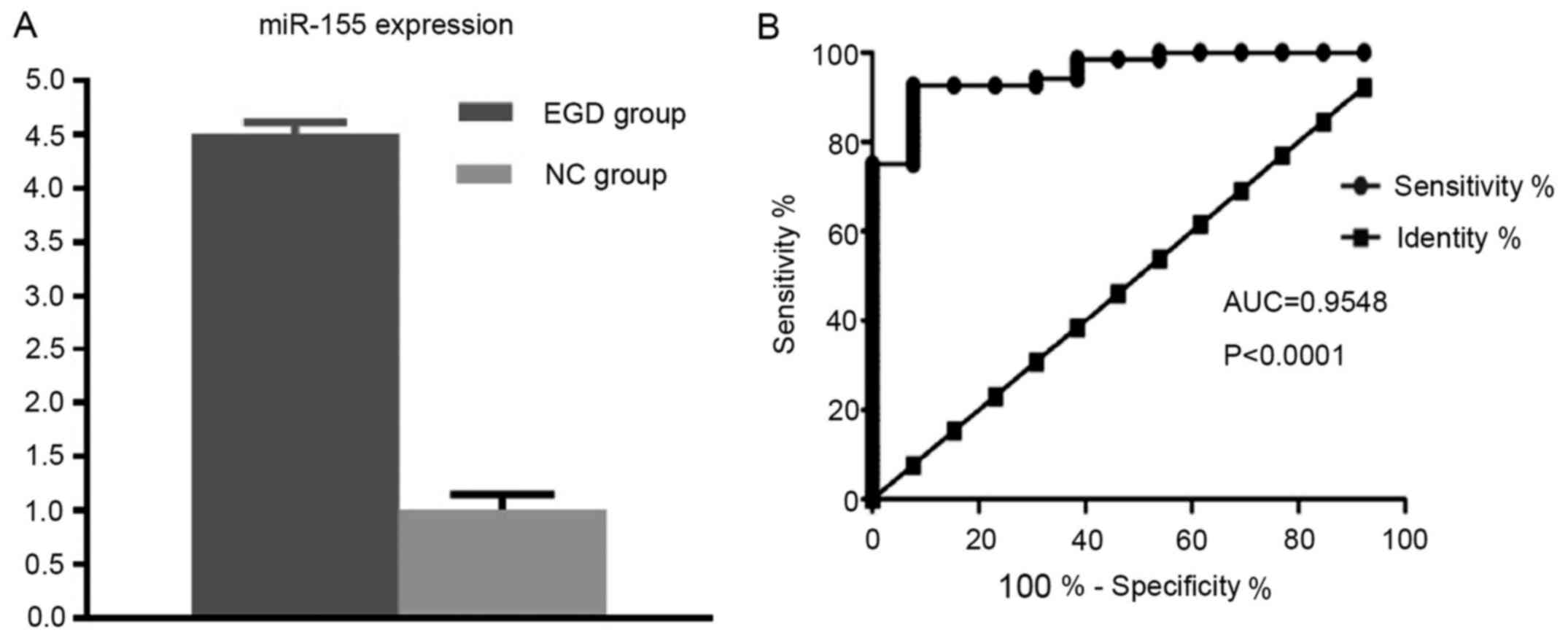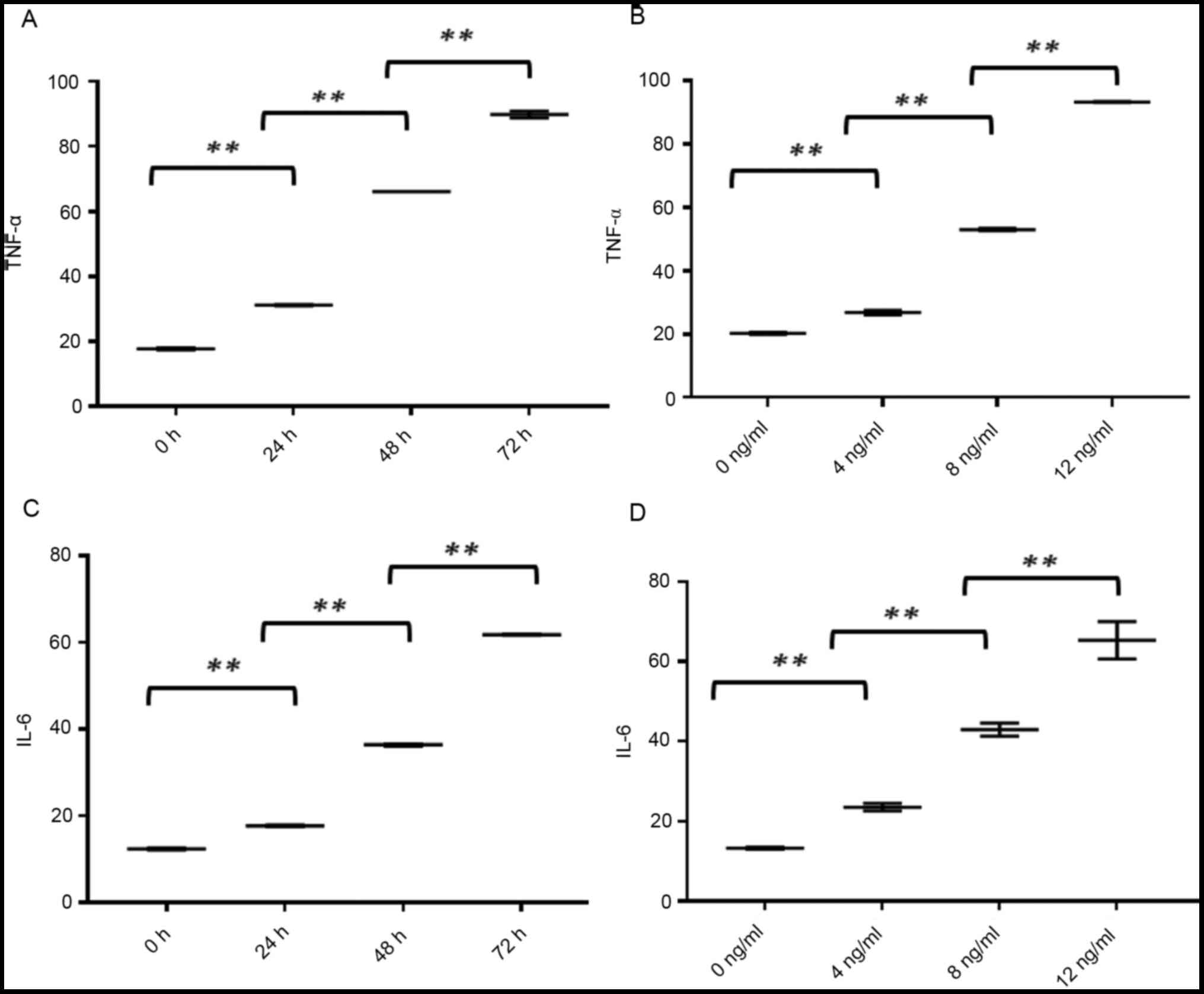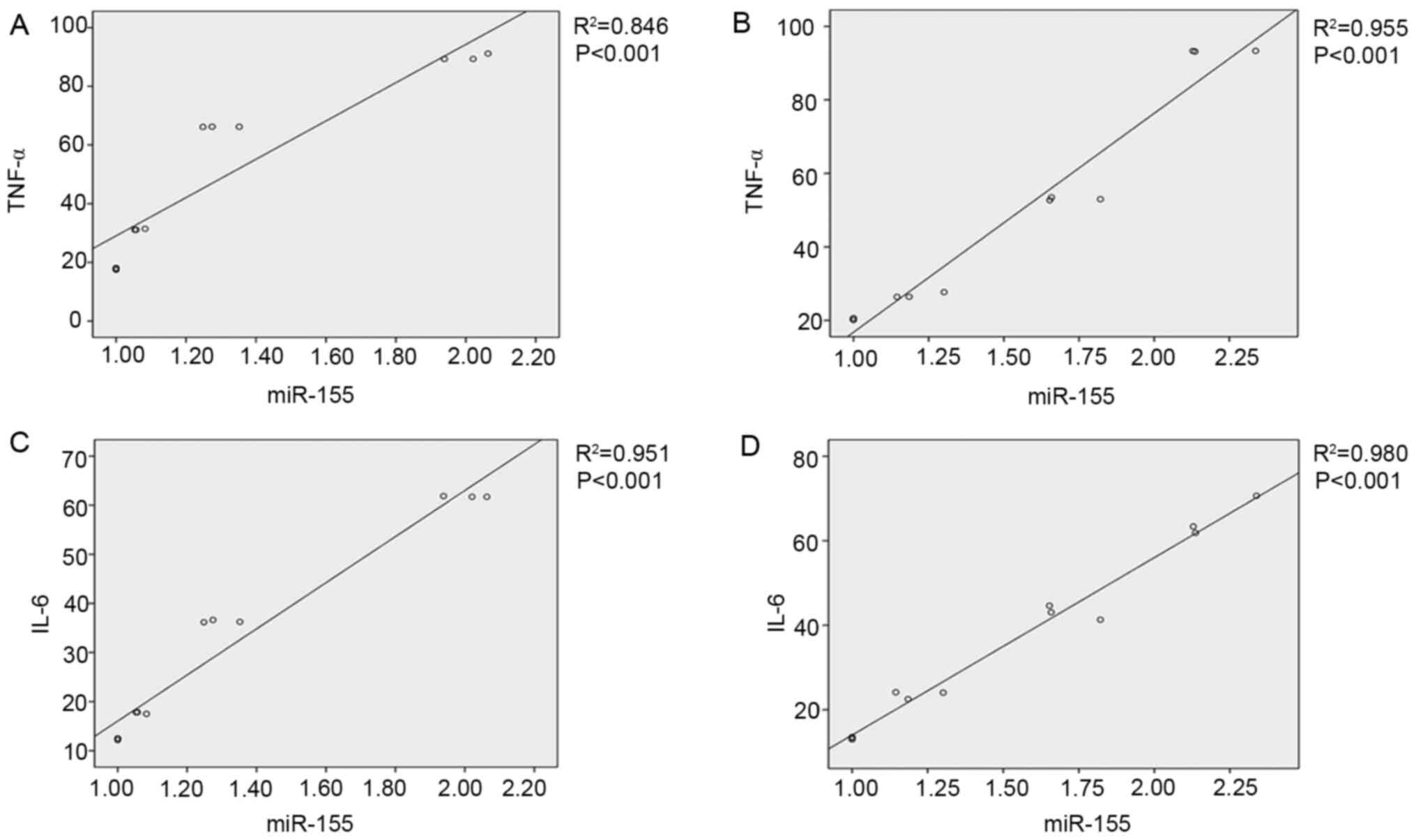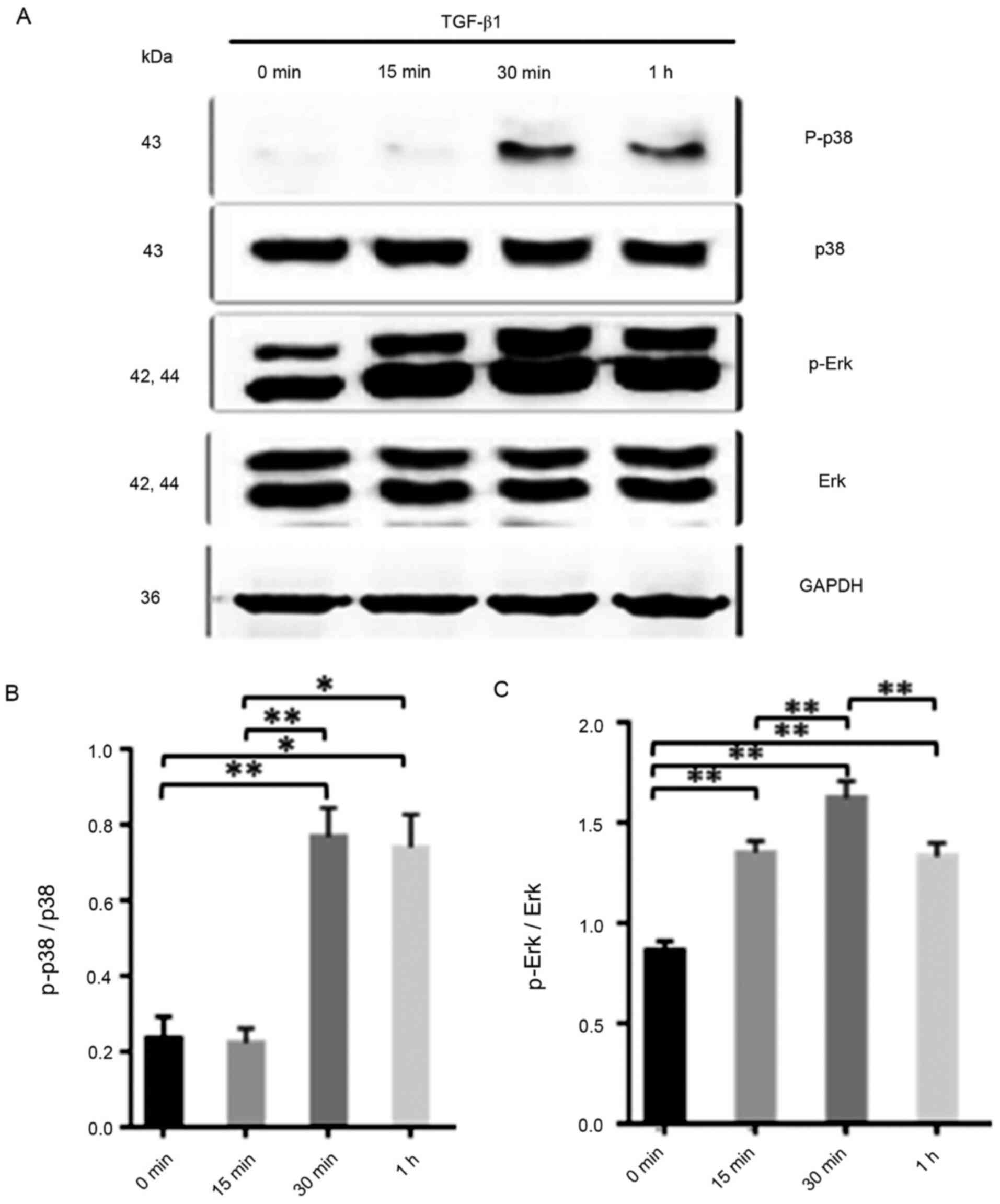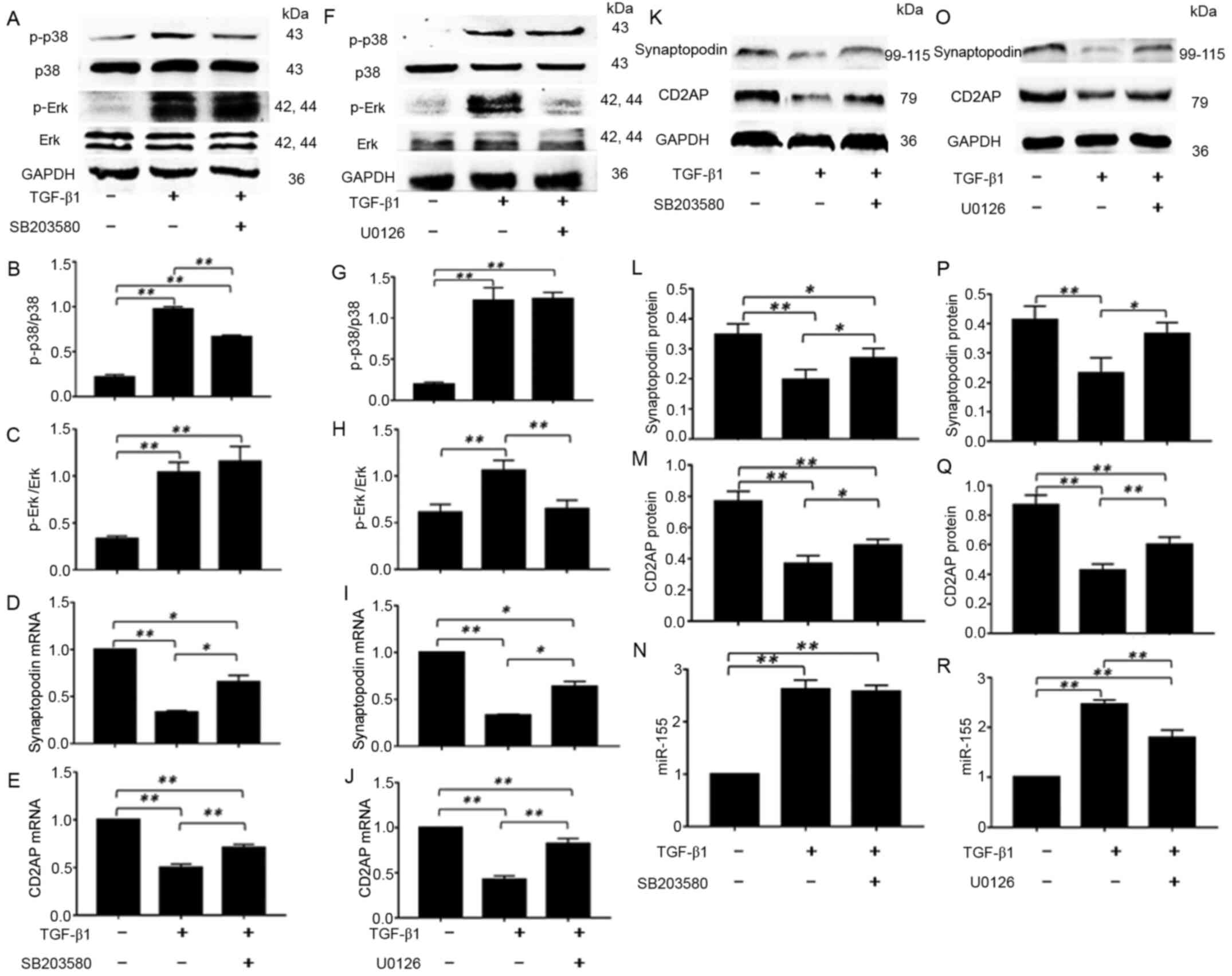|
1
|
Zhou L and Liu Y: Wnt/β-catenin signalling
and podocyte dysfunction in proteinuric kidney disease. Nat Rev
Nephrol. 11:535–545. 2015.PubMed/NCBI View Article : Google Scholar
|
|
2
|
D'Agati VD, Chagnac A, de Vries AP, Levi
M, Porrini E, Herman-Edelstein M and Praga M: Obesity-related
glomerulopathy: Clinical and pathologic characteristics and
pathogenesis. Nat Rev Nephrol. 12:453–471. 2016.PubMed/NCBI View Article : Google Scholar
|
|
3
|
Yaddanapudi S, Altintas MM, Kistler AD,
Fernandez I, Möller CC, Wei C, Peev V, Flesche JB, Forst AL, Li J,
et al: CD2AP in mouse and human podocytes controls a proteolytic
program that regulates cytoskeletal structure and cellular
survival. J Clin Invest. 121:3965–3980. 2011.PubMed/NCBI View
Article : Google Scholar
|
|
4
|
Perico L, Conti S, Benigni A and Remuzzi
G: Podocyte-actin dynamics in health and disease. Nat Rev Nephrol.
12:692–710. 2016.PubMed/NCBI View Article : Google Scholar
|
|
5
|
Tian X and Ishibe S: Targeting the
podocyte cytoskeleton: From pathogenesis to therapy in proteinuric
kidney disease. Nephrol Dial Transplant. 31:1577–1583.
2016.PubMed/NCBI View Article : Google Scholar
|
|
6
|
Mundel P, Heid HW, Mundel TM, Krüger M,
Reiser J and Kriz W: Synaptopodin: An actin-associated protein in
telencephalic dendrites and renal podocytes. J Cell Biol.
139:193–204. 1997.PubMed/NCBI View Article : Google Scholar
|
|
7
|
Asanuma K, Kim K, Oh J, Giardino L,
Chabanis S, Faul C, Reiser J and Mundel P: Synaptopodin regulates
the actin-bundling activity of alpha-actinin in an isoform-specific
manner. J Clin Invest. 115:1188–1198. 2005.PubMed/NCBI View
Article : Google Scholar
|
|
8
|
Shih NY, Li J, Karpitskii V, Nguyen A,
Dustin ML, Kanagawa O, Miner JH and Shaw AS: Congenital nephrotic
syndrome in mice lacking CD2-associated protein. Science.
286:312–315. 1999.PubMed/NCBI View Article : Google Scholar
|
|
9
|
Huang G, Lv J, Li T, Huai G, Li X, Xiang
S, Wang L, Qin Z, Pang J, Zou B, et al: Notoginsenoside R1
ameliorates podocyte injury in rats with diabetic nephropathy by
activating the PI3K/Akt signaling pathway. Int J Mol Med.
38:1179–1189. 2016.PubMed/NCBI View Article : Google Scholar
|
|
10
|
Koga K, Yokoi H, Mori K, Kasahara M,
Kuwabara T, Imamaki H, Ishii A, Mori KP, Kato Y, Ohno S, et al:
MicroRNA-26a inhibits TGF-β-induced extracellular matrix protein
expression in podocytes by targeting CTGF and is downregulated in
diabetic nephropathy. Diabetologia. 58:2169–2180. 2015.PubMed/NCBI View Article : Google Scholar
|
|
11
|
Li Z and Rana TM: Therapeutic targeting of
microRNAs: Current status and future challenges. Nat Rev Drug
Discov. 13:622–638. 2014.PubMed/NCBI View
Article : Google Scholar
|
|
12
|
Hausser J and Zavolan M: Identification
and consequences of miRNA-target interactions - beyond repression
of gene expression. Nat Rev Genet. 15:599–612. 2014.PubMed/NCBI View
Article : Google Scholar
|
|
13
|
Mashima R: Physiological roles of miR-155.
Immunology. 145:323–333. 2015.PubMed/NCBI View Article : Google Scholar
|
|
14
|
Lin X, You Y, Wang J, Qin Y, Huang P and
Yang F: MicroRNA-155 deficiency promotes nephrin acetylation and
attenuates renal damage in hyperglycemia-induced nephropathy.
Inflammation. 38:546–554. 2015.PubMed/NCBI View Article : Google Scholar
|
|
15
|
Chen XW, Liu WT, Wang YX, Chen WJ, Li HY,
Chen YH, Du XY, Peng FF, Zhou WD, Xu ZZ, et al:
Cyclopropanyldehydrocostunolide LJ attenuates high glucose-induced
podocyte injury by suppressing RANKL/RANK-mediated NF-κB and MAPK
signaling pathways. J Diabetes Complications. 30:760–769.
2016.PubMed/NCBI View Article : Google Scholar
|
|
16
|
Chuang PY and He JC: Signaling in
regulation of podocyte phenotypes. Nephron, Physiol. 111:9–15.
2009.PubMed/NCBI View Article : Google Scholar
|
|
17
|
Kaminska B: MAPK signalling pathways as
molecular targets for anti-inflammatory therapy - from molecular
mechanisms to therapeutic benefits. Biochim Biophys Acta.
1754:253–262. 2005.PubMed/NCBI View Article : Google Scholar
|
|
18
|
Kim Y, Lim HJ, Jang HJ, Lee S, Jung K, Lee
SW, Lee SJ and Rho MC: Portulaca oleracea extracts and their active
compounds ameliorate inflammatory bowel diseases in vitro and in
vivo by modulating TNF-α, IL-6 and IL-1β signalling. Food Res Int.
106:335–343. 2018.PubMed/NCBI View Article : Google Scholar
|
|
19
|
Han R, Zhang F, Wan C, Liu L, Zhong Q and
Ding W: Effect of perfluorooctane sulphonate-induced Kupffer cell
activation on hepatocyte proliferation through the
NF-κB/TNF-α/IL-6-dependent pathway. Chemosphere. 200:283–294.
2018.PubMed/NCBI View Article : Google Scholar
|
|
20
|
Yoshimura A, Wakabayashi Y and Mori T:
Cellular and molecular basis for the regulation of inflammation by
TGF-beta. J Biochem. 147:781–792. 2010.PubMed/NCBI View Article : Google Scholar
|
|
21
|
Chapnick DA, Warner L, Bernet J, Rao T and
Liu X: Partners in crime: The TGFβ and MAPK pathways in cancer
progression. Cell Biosci. 1(42)2011.PubMed/NCBI View Article : Google Scholar
|
|
22
|
Huang H, You Y, Lin X, Tang C, Gu X, Huang
M, Qin Y, Tan J and Huang F: Inhibition of TRPC6 signal pathway
alleviates podocyte injury induced by TGF-β1. Cell Physiol Biochem.
41:163–172. 2017.PubMed/NCBI View Article : Google Scholar
|
|
23
|
Livak KJ and Schmittgen TD: Analysis of
relative gene expression data using real-time quantitative PCR and
the 2(-Delta Delta C(T)) method. Methods. 25:402–408.
2001.PubMed/NCBI View Article : Google Scholar
|
|
24
|
Koshikawa M, Mukoyama M, Mori K, Suganami
T, Sawai K, Yoshioka T, Nagae T, Yokoi H, Kawachi H, Shimizu F, et
al: Role of p38 mitogen-activated protein kinase activation in
podocyte injury and proteinuria in experimental nephrotic syndrome.
J Am Soc Nephrol. 16:2690–2701. 2005.PubMed/NCBI View Article : Google Scholar
|
|
25
|
Wickman L, Afshinnia F, Wang SQ, Yang Y,
Wang F, Chowdhury M, Graham D, Hawkins J, Nishizono R, Tanzer M, et
al: Urine podocyte mRNAs, proteinuria, and progression in human
glomerular diseases. J Am Soc Nephrol. 24:2081–2095.
2013.PubMed/NCBI View Article : Google Scholar
|
|
26
|
Toyoda M, Najafian B, Kim Y, Caramori ML
and Mauer M: Podocyte detachment and reduced glomerular capillary
endothelial fenestration in human type 1 diabetic nephropathy.
Diabetes. 56:2155–2160. 2007.PubMed/NCBI View Article : Google Scholar
|
|
27
|
Masum MA, Ichii O, Elewa YH, Nakamura T,
Otani Y, Hosotani M and Kon Y: Modified scanning electron
microscopy reveals pathological crosstalk between endothelial cells
and podocytes in a murine model of membranoproliferative
glomerulonephritis. Sci Rep. 8(10276)2018.PubMed/NCBI View Article : Google Scholar
|
|
28
|
Mallipattu SK and He JC: Podocyte as a
direct target for treatment of glomerular disease? Am J Physiol
Renal Physiol. 311:F46–F51. 2016.PubMed/NCBI View Article : Google Scholar
|
|
29
|
Verheijden KA, Sonneveld R, Bakker-van
Bebber M, Wetzels JF, van der Vlag J and Nijenhuis T: The
calcium-dependent protease calpain-1 links TRPC6 activity to
podocyte injury. J Am Soc Nephrol. 29:2099–2109. 2018.PubMed/NCBI View Article : Google Scholar
|
|
30
|
Qiao J, Liu Y, Jiang Z, Yang Y, Liu W and
Han B: Preparation and renoprotective effects of carboxymethyl
chitosan oligosaccharide on adriamycin nephropathy. Carbohydr
Polym. 201:347–356. 2018.PubMed/NCBI View Article : Google Scholar
|
|
31
|
Dos Santos M, Poletti PT, Favero G,
Stacchiotti A, Bonomini F, Montanari CC, Bona SR, Marroni NP,
Rezzani R and Veronese FV: Protective effects of quercetin
treatment in a pristane-induced mouse model of lupus nephritis.
Autoimmunity. 51:69–80. 2018.PubMed/NCBI View Article : Google Scholar
|
|
32
|
Ishikawa M, Kobayashi N, Sugiyama F, Onoda
S and Ishimitsu T: Renoprotective effect of vasopressin v2 receptor
antagonist tolvaptan in Dahl rats with end-stage heart failure. Int
Heart J. 54:98–106. 2013.PubMed/NCBI View Article : Google Scholar
|
|
33
|
Tu Y, Sun W, Wan YG, Che XY, Pu HP, Yin
XJ, Chen HL, Meng XJ, Huang YR and Shi XM: Huangkui capsule, an
extract from Abelmoschus manihot (L.) medic, ameliorates
adriamycin-induced renal inflammation and glomerular injury via
inhibiting p38MAPK signaling pathway activity in rats. J
Ethnopharmacol. 147:311–320. 2013.PubMed/NCBI View Article : Google Scholar
|
|
34
|
Saikumar J, Hoffmann D, Kim TM, Gonzalez
VR, Zhang Q, Goering PL, Brown RP, Bijol V, Park PJ, Waikar SS, et
al: Expression, circulation, and excretion profile of microRNA-21,
-155, and -18a following acute kidney injury. Toxicol Sci.
129:256–267. 2012.PubMed/NCBI View Article : Google Scholar
|
|
35
|
Beltrami C, Simpson K, Jesky M, Wonnacott
A, Carrington C, Holmans P, Newbury L, Jenkins R, Ashdown T, Dayan
C, et al: Association of elevated urinary miR-126, miR-155, and
miR-29b with diabetic kidney disease. Am J Pathol. 188:1982–1992.
2018.PubMed/NCBI View Article : Google Scholar
|
|
36
|
Yang X, Zhang J and Ding Y: Association of
microRNA-155, interleukin 17A, and proteinuria in preeclampsia.
Medicine (Baltimore). 96(e6509)2017.PubMed/NCBI View Article : Google Scholar
|
|
37
|
Neilsen PM, Noll JE, Mattiske S, Bracken
CP, Gregory PA, Schulz RB, Lim SP, Kumar R, Suetani RJ, Goodall GJ,
et al: Mutant p53 drives invasion in breast tumors through
up-regulation of miR-155. Oncogene. 32:2992–3000. 2013.PubMed/NCBI View Article : Google Scholar
|
|
38
|
Yao J, Du X, Chen S, Shao Y, Deng K, Jiang
M, Liu J, Shen Z, Chen X and Feng G: Rv2346c enhances mycobacterial
survival within macrophages by inhibiting TNF-α and IL-6 production
via the p38/miRNA/NF-κB pathway. Emerg Microbes Infect.
7(158)2018.PubMed/NCBI View Article : Google Scholar
|
|
39
|
Park M, Choi S, Kim S, Kim J, Lee DK, Park
W, Kim T, Jung J, Hwang JY, Won MH, et al: NF-κB-responsive miR-155
induces functional impairment of vascular smooth muscle cells by
downregulating soluble guanylyl cyclase. Exp Mol Med. 51:1–12.
2019.PubMed/NCBI View Article : Google Scholar
|
|
40
|
Peng W, Zhao N, Liu Q, Nie C, Qing C, Shao
Q, Liu F, Qian K and Ding C: MicroRNA-155 reduces inflammatory
response induced by lipopolysaccharide in alveolar macrophages.
Zhonghua Wei Zhong Bing Ji Jiu Yi Xue. 30:1061–1065.
2018.PubMed/NCBI View Article : Google Scholar : (In Chinese).
|
|
41
|
Mann M, Mehta A, Zhao JL, Lee K, Marinov
GK, Garcia-Flores Y, Lu LF, Rudensky AY and Baltimore D: An
NF-kappaB-microRNA regulatory network tunes macrophage inflammatory
responses. Nat Commun. 8(851)2017.PubMed/NCBI View Article : Google Scholar
|
|
42
|
Joyce CE and Novina CD: miR-155 in acute
myeloid leukemia: Not merely a prognostic marker? J Clin Oncol.
31:2219–2221. 2013.PubMed/NCBI View Article : Google Scholar
|
|
43
|
Chakraborty C, Sharma AR, Patra BC,
Bhattacharya M, Sharma G and Lee SS: MicroRNAs mediated regulation
of MAPK signaling pathways in chronic myeloid leukemia. Oncotarget.
7:42683–42697. 2016.PubMed/NCBI View Article : Google Scholar
|
|
44
|
Wang RM, Wang ZB, Wang Y, Liu WY, Li Y,
Tong LC, Zhang S, Su DF, Cao YB, Li L, et al: Swiprosin-1 promotes
mitochondria-dependent apoptosis of glomerular podocytes via P38
MAPK pathway in early-stage diabetic nephropathy. Cell Physiol
Biochem. 45:899–916. 2018.PubMed/NCBI View Article : Google Scholar
|
|
45
|
Zhu Y: PRMT1 mediates podocyte injury and
glomerular fibrosis through phosphorylation of ERK pathway. Biochem
Biophys Res Commun. 495:828–838. 2018.PubMed/NCBI View Article : Google Scholar
|
|
46
|
Fogo AB and Kon V: The glomerulus - a view
from the inside - the endothelial cell. Int J Biochem Cell Biol.
42:1388–1397. 2010.PubMed/NCBI View Article : Google Scholar
|















